MONDAY
JUNE 23 - 2014
Beautiful
Demoiselles
Jane Brook and
I met at the south bridge of Brook Meadow to carry on
with the regular surveys of the Emsworth waysides.
While we were there we got excellent views of two
demoiselle damselflies fluttering around on the
vegetation above the river. They both settled for a
while enabling closer inspection.
One was certainly a male Beautiful Demoiselle with
fully blue wings. The other was probably a female
Beautiful Demoiselle, but this insect is difficult to
separate from the female Banded Demoiselle.
male
Beautiful Demoiselle
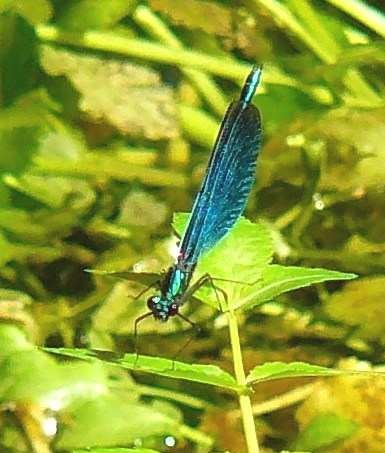
|
female
(Beautiful) Demoiselle
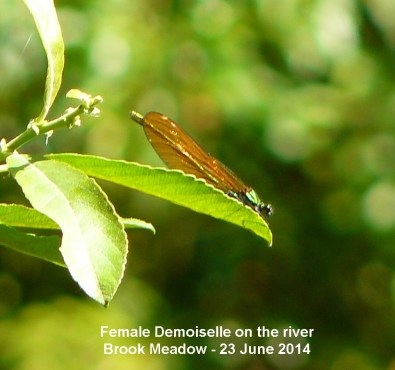
|
The more common Banded
Demoiselle has a dark band across its wings. This was
our second sighting of a Beautiful Demoiselle on Brook
Meadow this summer; Francis Kinsella got the first on
June 17th. The very first Beautiful Demoiselle was
recorded on Brook Meadow in 2008 and it has been seen
each year since then.
Waysides
News
From the south
bridge Jane and I went through the underpass to look
at the Lillywhite's path wayside. Jane asked me to
check on the Holm Oak (Quercus ilex) which is
fairly abundant on this wayside. Rose says it was
introduced from the Mediterranean, so is not
native.
The most interesting discovery of the morning was a
flowering plant of Fool's Parsley at the back
of Lillywhite's Garage. This plant is easily
identified from the distinctive bracteoles hanging
from the flower heads. It gets its name from its
resemblence to Parsley and the fact that only a fool
would eat it as it is highly poisonous!
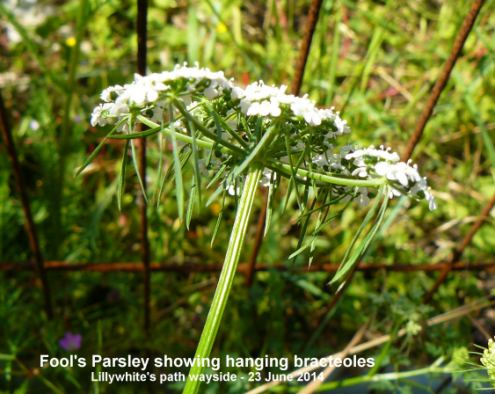
We checked the A259
embankment in the centre of town where we found a good
flowering of Perennial Sow-thistle.
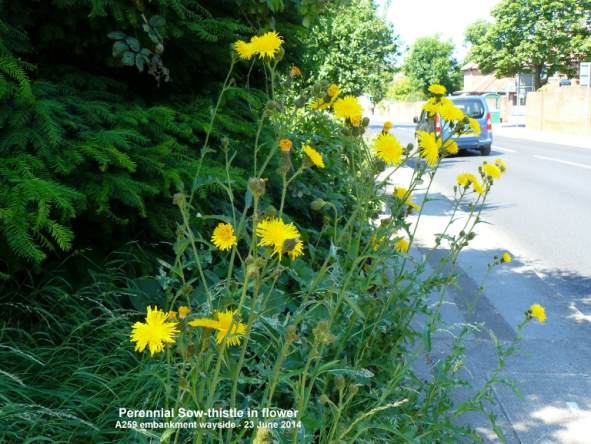
On the Dolphin Creek
wayside we found Saltmarsh Rush, but the Lesser
Sea-spurrey was not in flower. The leaves of the large
Horse Chestnut tree in the garden of Holmwood House
are severely infested with the leaf miner grub of the
moth Cameraria ohridella.
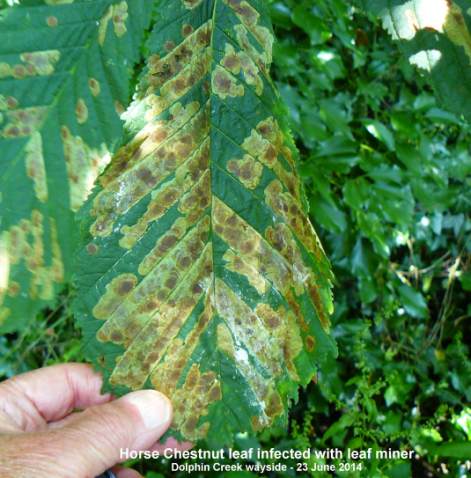
The larvae of the
Horse Chestnut leaf miner moth digs 'mines' within the
leaves which produce a characteristic browning of the
leaf between the veins. The larvae themselves can
easily be seen (and felt) as dark lumps in the
leaf.
The leaf miner disease was first observed in Macedonia
in northern Greece in the late 1970's and has since
spread throughout central and eastern Europe. It was
first found established in the UK in Wimbledon in July
2002. From this initial area of infestation, the moth
has spread rapidly, and it is now present across most
of south-central England, East Anglia and the
Midlands.
Despite the poor appearance of horse-chestnut trees
infested with C. ohridella, there is no evidence that
damage by the moth leads to a decline in tree health,
the development of dieback, or tree death. Trees
survive repeated infestations and re-flush normally in
the following year. It appears that most of the damage
caused by the moth occurs too late in the growing
season to greatly affect tree performance. See . . .
http://www.forestry.gov.uk/pdf/Horsechestnut.pdf/$FILE/Horsechestnut.pdf
Record
orchid count
Nigel Johnson
sent me the details of Saturday's annual count carried
out by the Havant Wildlife Group of the Southern Marsh
Orchids on the South Moor at Langstone. It was a new
record with a grand total of 10,690 flowering spikes
counted! This beat the previous best of 9,234 in 2010
by over a thousand. Nigel explained that this year's
count was more difficult than usual as the vegetation
had grown to up to six feet in places; the count
usually takes about an hour and a half, but this year
it took three hours.
The Southern Marsh Orchid counts have been taking
place for the last 19 years in the field to the south
of the Autoliv factory in Langstone Grid Ref: SU 712
052. In 1995 and 1996 Ralph Hollins counted them and
since then they have been counted by the local HWT
Havant Wildlife Study Group.
Here is a view across the South Moor, which is a
Hampshire Wildlife Trust reserve, that I took last
year before the orchids. The factory can just be seen
in the background.
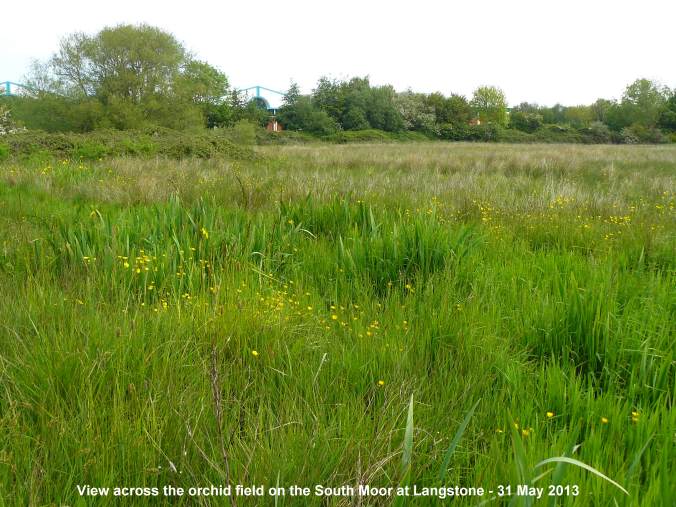
SUNDAY
JUNE 22 - 2014
Brook
Meadow
I had a slow
walk around the meadow this morning, too hot really
for anything else! Birds are still singing,
Chiffchaff, Blackcap, Whitethroat, Dunnock,
Woodpigeon, Stock Dove.
I noted a couple of spikes of Bread Wheat on
the side of the path to the bridge on the Seagull Lane
patch. Obviously casuals, but firsts for the
meadow.
Plenty of Meadow Browns were flying plus a few
Skippers, but none settled for a photo.
The Oak sapling I planted on the Seagull Lane patch in
2012 is now taller than me!
On the orchid area the Great Burnet is still
looking very good with the bright red flower heads
standing out prominently.

Nearby I found another
two Bee Orchids on the orchid area in addition
to the group of five that were marked earlier by
myself and Jill Stanley. One of these was marked with
a twig by someone else. The other one was nearby but
not marked. It is now. This means we have located 7
Bee Orchids on the orchid area this year plus another
5 on the centre meadow, making 12 in all. This equals
our previous best total of 12 in 2009.
I checked the Blue Water-speedwell flower spikes on
the river bank in Palmer's Road Copse, but they are
mostly long, indicating the hybrid - Veronica x
Lackschewitzii. Brooklime is now in flower on
the river bank.
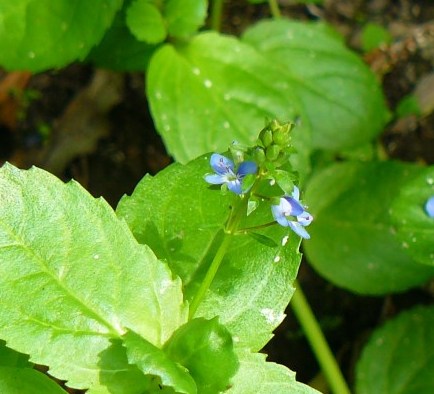
Millpond
News
The Mute Swan
still sits high on her nest near the bridge on the
town millpond, much watched as always by people
passing. She had the company today of a Mallard family
of mum and six tiny ducklings.
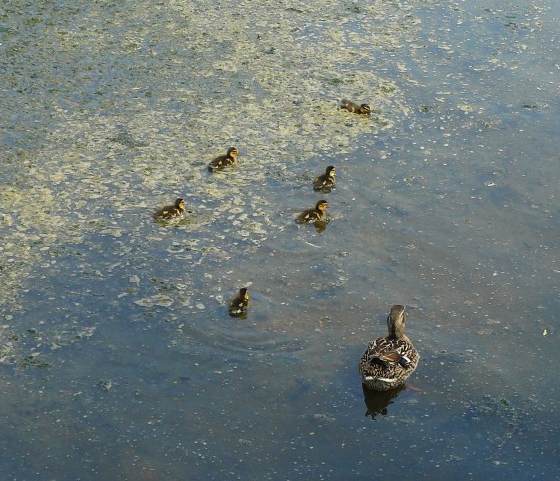
Hampshire
Farm news
Chris Oakley
also had Mallard ducklings - 8 of them - on the
attenuation pond of the Hampshire Farm site. Chris
says, there is no sign of a male (that's not
surprising!) and she leaves the chicks for frequent
short spells. The young wait on the rim of the outfall
and as soon as she returns they all dive for cover,
though one would think it would be the other way
round.
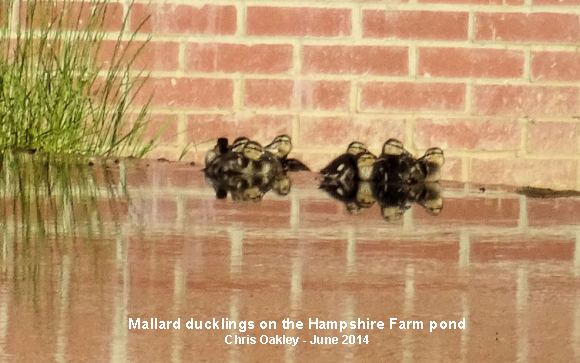
Waysides
News
The
Pyramidal Orchid on the Bridge Road Wayside is
developing well.
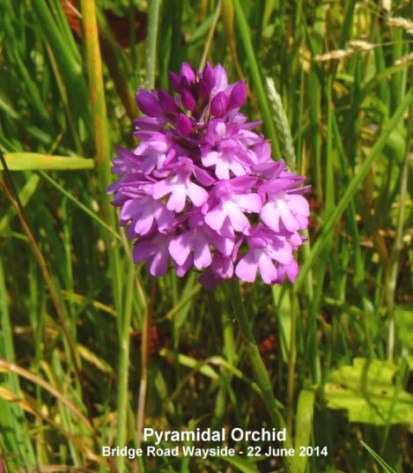
Starling
behaviour
Caroline
French posted the following observation on Starling
behaviour on Hoslist
"This year I put up a Starling box on the side of the
house. Although a male did build a nest inside and
spent a lot of time singing from it, in the end it
didn't nest there. In fact, it emptied out the box,
taking every last scrap of nesting material elsewhere
and leaving nothing but a load of droppings all over
the wall.
What has surprised me is the amount of interest shown
in the box by juvenile Starlings. They have been in
and out of it and squabbling over it. This morning a
juvenile was walking around with a large piece of
straw as though it planned to use it for nesting
material. I know the juveniles won't be nesting this
year but I wonder whether there is an urge even at
this stage to identify sites for next year.
On the subject of juvenile Starlings, you might like
to see this video I took a few years back of birds
seemingly enjoying the heat of a security light in
Portchester . . . " http://www.youtube.com/watch?v=eFLCMiVaIOE
Hayling
Oysterbeds
Chris
Cockburn's latest news update from the oysterbeds.
"Things are still going well for most of the nesting
birds at the Hayling Oysterbeds.
The black-headed gulls still have many broods
of three (quite a few even 'flying', albeit, not
perfectly, yet). So far, it seems that these gulls are
having a very productive year at this site.
The (admittedly small
sample) of nesting Mediterranean gulls do not
seem to be so productive; of the nine original nesting
pairs, only six seem to have young (mostly 'twins'
rather than 'triplets' that would be expected
following a very 'earthwormy' winter. At least two of
the original nesting pairs included 2nd summer birds
and that might explain the apparent 'failures'. It
might be a result of my AMD vision problem (even
through a telescope), but the adult Mediterranean
gull(s) on the northern side of the 'straight' western
island has/have been rarely seen , whilst the two
chicks are still present. So, perhaps it is a case of
a 'lone parent' successfully raising chicks - that is
very interesting; but given the strong territorial
behaviour of gull chicks, it should not be surprising
that they might easily "look after themselves" when
the parent is away.
Common tern
(nest) numbers are now 75+, with most on the north
side of the straight (western) island and the first
chicks might be seen soon. The common terns do seem to
like the Oysterbeds' islands, which have c75% of the
harbour population this year.
There are still two
'apparently occupied' oystercatcher nests, one
on the northern side of the straight island and the
other (much harder to see) on the inside of the curved
island. The family group of two adults with two small
chicks has not been seen since last Tuesday, but
hopefully, they have found a safe refuge nearby.
Butterflies continue
to be uncooperative for photographing, but there are
profuse amounts of Marbled Whites (my favourite
'brown' butterfly, see photo below - here on Tufted
vetch).

The best of
flora/fauna is presently south of the Hayling Halt
(Esso garage) car park on the Billy Trail. Just a few
yards onto the trail and you are into flowering
samples of Knapweed, Wild Radish, Salsify, Meadow
vetchling, Pale flax, Rosebay-willowherb, Wild carrot,
Meadowsweet etc. The 'Mound' by the Oysterbeds' lagoon
also has a very good variety of plants including good
displays of Bird's-foot trefoil, Viper's bugloss,
Common centaury, Scarlet pimpernel, Milk thistle etc
and a flowering Pyramidal orchid was found there on
Sat. by Steve Cook.
Clam-dredging continues on a very high scale with as
many as four dredgers intensively working the NE parts
of the harbour, often as close inshore as possible.
There is no close-season for clam gathering and the
only restrictions apply to the size of the quarry.
FRIDAY
JUNE 20 - 2014
White
Admirals in Hollybank Woods
Following the
sighting by Barry Collins of 7 White Admirals and 5
Silver-washed Fritillaries in Havant Thicket yesterday
(posted on Hants Butterfly Conservation), I thought I
would nip up to Hollybank on the bike to have a look
for them there. I met Andy Brook and his apprentice
Andrew clearing the eastern bridleway. Andy confirmed
there had been no White Admiral sightings in the woods
as yet. However, this is about the date when I usually
see the first one, so I was optimistic. My earliest
ever sighting was 16-Jun-2007.
I went to the Lorton log seat further along on the
eastern bridleway, which is my usual White Admiral
'hot spot'. After about 5 mins (at about 11:30) I saw
the distinctive fluttering flight of a White Admiral
high up in the Hazel to the west of the seat. It
fluttered around for about 3 minutes, before I lost
it. It did not rest, so I was not able to get a
photo.
On the way home, I stopped for a while at another of
my hot spots, in the clear area just north of the
interpretation board near the southern entrance. After
a few minutes another White Admiral appeared
fluttering in the Sweet Chestnut trees, disturbed by a
passing horse rider, but again a photo was not
possible. Here is one I got in Hollybank Woods in
2010.

The only other
butterflies I saw were Speckled Wood and Meadow Brown.
Here is a female Meadow Brown which has a
larger single-pupilled eyespot than the male.
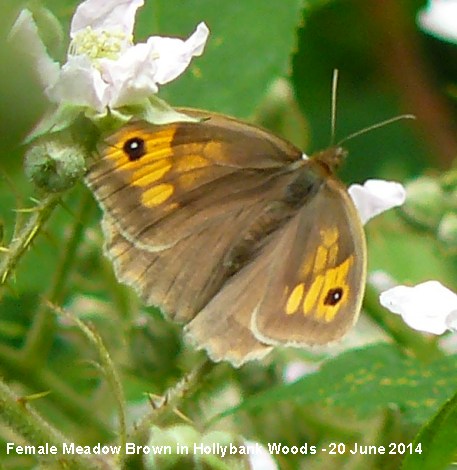
Commas
on Brook Meadow
Francis
Kinsella was on Brook Meadow today where he found lots
of Comma butterflies. Here is a a photo of one
clearly showing the white comma on the underwing from
which the insect gets its name.
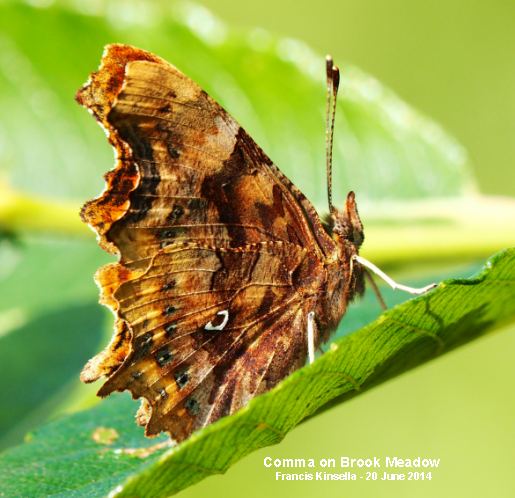
Speckled
Bush-cricket
Jill Stanley
found this Speckled Bush-cricket on the Buddleia in
her garden this afternoon. What wonderful
antennae!
Jill assumes it is a male as it did not have the
curved ovipositor of a female bush-cricket. One
puzzling feature is that according to my book both
sexes of Speckled Bush-cricket have a brown line down
their backs, but Jill's insect does not have one.
Maybe, it is a youngster?
Ralph Hollins agrees that Jill's Bush Cricket is not
yet mature and to support this provides the following
link which says .. "The nymphs emerge in May and June
and mature as adult speckled bush crickets by mid
August."
http://www.rspb.org.uk/wildlife/wildlifegarden/atoz/s/speckledbushcricket.aspx
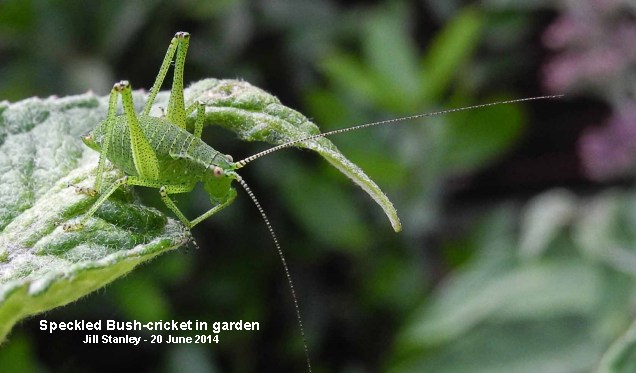
THURSDAY
JUNE 19 - 2014
BROOK
MEADOW
New tool shed
I got over to
Brook Meadow just in time to see the delivery and
positioning of the new tool shed on the south side of
the Seagull Lane patch. Maurice Lillie was there to
supervise the operation and Martin Shelley to take
photos for The Ems. I also took a few! The shed fitted
into the space cleared for it very neatly and its
green colour blends in well with the surrounding
vegetation.
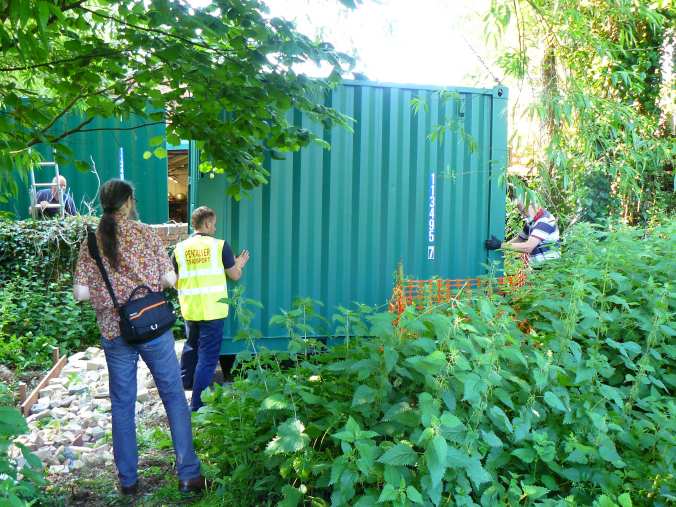
Workday
Ten volunteers
attended this morning's conservation work session. The
main task was cutting back the overhanging vegetation
on the paths. I had to warn them to avoid the
Festulolium Hybrids and a new growth of Plicate
Sweet-grass on the path near Beryl's seat. We all had
coffee in the new shed. It needs a sofa!
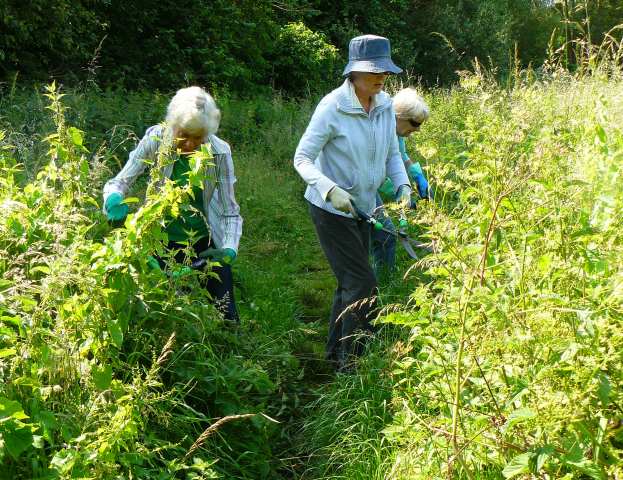
Wildlife
Blackcap,
Chiffchaff and Whitethroat were singing, but
not much else.
Plenty of Meadow Browns were fluttering around
the grassland, but none stopped long enough for me to
see if there was a Ringlet. Other butterflies seen
were Red Admiral and Common Blue.
Red Bartsia is now flowering generally on the
Lumley area. Timothy is starting to emerge on the
Lumley area.
I met Malcolm Phillips
who showed me the location of four more Bee Orchids
that he had located, 3 on the Lumley area and one
on the centre meadow. This takes the total number of
Bee Orchids on Brook Meadow this year to 9. The record
for Brook Meadow is 12 in 2009.
Bee Orchid Grid Refs. Total = 9
One on Lumley area (north) - SU 75143 06042 - Brian
Fellows
Three on the Lumley area - SU 75127 06042 - Malcolm
Phillips
One on centre meadow - SU 75114 06027 - Malcolm
Phillips
Four on orchid area SU 75063 06141 - Brian Fellows
& Jill Stanley
Frog
Malcolm
Phillips got this photo of a Frog on the meadow.

Mystery
insect
Regarding the
mystery fly Malcolm Phillips found on Brook Meadow
yesterday
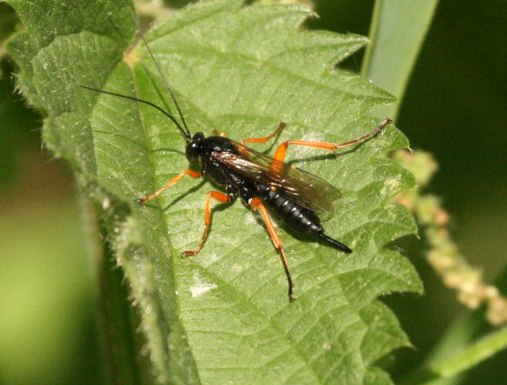
Ralph Hollins says the
nearest match he can find to the long antennae, black
body, yellow legs and ovipositor is Dyspetes
praerogator . See . . . http://www.naturespot.org.uk/species/dyspetes-praerogator
However, as this seems to be an uncommon species it is
perhaps unlikely.
WEDNESDAY
JUNE 18 - 2014
Brook
Meadow
Malcolm
Phillips got some nice photos of butterflies on Brook
Meadow today, including the first Ringlet of the
year. This was, in fact, the earliest Ringlet I
have on my records for Brook Meadow.

Malcolm got a Water
Vole swimming beneath the south bridge. That makes
19 sightings from this spot. We have had no others
from anywhere else on the river for over a month.
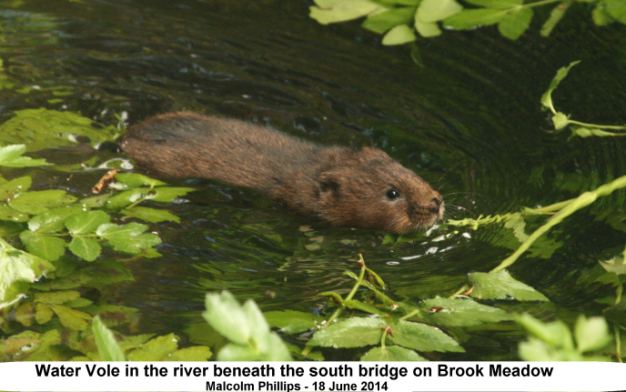
Malcolm also got a
photo of what looks like a Sawfly with a long
ovipositor. I am wondering if it could be a Horntail
though the all black body is not expected. From my
books the Horntail's body is at least partly yellow.

Beautiful
Demoiselle
Francis
Kinsella took this photo yesterday evening (June 17)
on Brook Meadow of what looks like an immature male
Beautiful Demoiselle, our first of the year. What a
cracking insect.
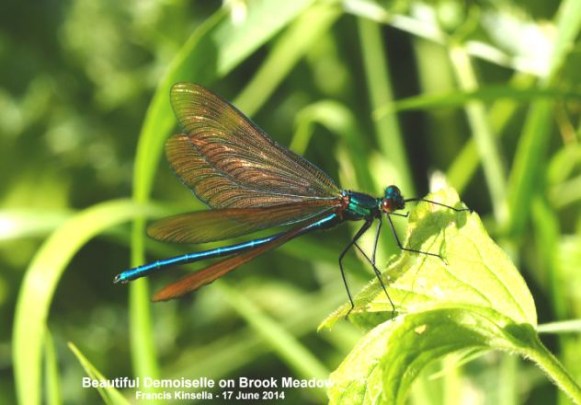
The first Beautiful
Demoiselle was recorded on Brook Meadow in 2008 and it
has been seen each year since then. Males are
distinguished from the more common Banded Demoiselle
from the wing pigment which covers virtually all of
the wings, unlike in the Banded Demoiselle where there
is just a dark band across the wings.
Swan
attack at Nore Barn
Maggie Gebbett
witnessed yet another swan attack at 8am this morning
at Nore Barn. It was the same dogs as before and she
has informed police, RSPCA, etc. Later this afternoon,
Maggie saw all three cygnets in the harbour and a
rather muddy looking adult swan plus the one that
managed to get airborne and escape. So, thankfully, it
seems no permanent injury was done, but this
indicates, as Maggie says, just how aware dog owners
need to be of the swans.
Hampshire
Farm
Chris Oakley
did a walk around the Hampshire Farm open space area
with his new Garmin eTrex 10 to determine its size -
38.2 acres in all, the pond area alone is 1.7 acres
and the actual pond is .7 acres. Chris says, "I walked
the perimeter as close to the fence as I could, this
being the roughest strip to walk. My ankles are
covered in small scratches from briars and brambles. I
put up a fox at the top end but there was no sign of
the deer. The area originally set aside for a nature
site is now included in the main open space. The
horses are gone and the fences have been removed. The
land is in pretty good order and it should recover
this year."
TUESDAY
JUNE 17 - 2014
Millpond
News
This morning,
I got the bike out and cycled down to Thorney Island
via the millponds. Stopping briefly at the bridge on
the town millpond, I could see the swan standing up on
its nest revealing six eggs. She was closely watched
by many other people passing by. On Peter Pond, I
could see the Mute Swan family still had two
cygnets.
Over on Slipper Millpond, both Great Black-backed
Gulls were on the centre raft, but I could not see the
chick in the dense vegetation.
I had a look at the pond south of the Deckhouses
Estate, where the pair of Mute Swans that I have seen
several times previously were still there. One of the
swans was sitting on a rather makeshift nest on the
small island while its mate was on the water nearby. I
do not rate this pair very highly for breeding.
Swallows were flying over the stables along the NRA
track across North Thorney.
Plant
news
Lesser
Sea-spurrey is starting to flower near the
Chequers Quay gate on the west side of Slipper
Millpond.
There is also a tuft of Water Bent grass coming
up beside the wall nearby.
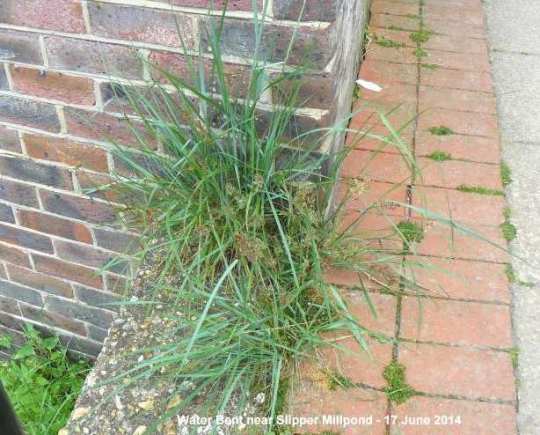
Hedgerow
Crane's-bill is in flower on the east side of
Slipper Millpond; I do not recall having seen this
plant here before. Ground-elder is also in flower.
Crow Garlic bulbils are prominent on the east side of
the pond.
On the marina seawall Bristly Ox-tongue and
Hemlock are both in flower.
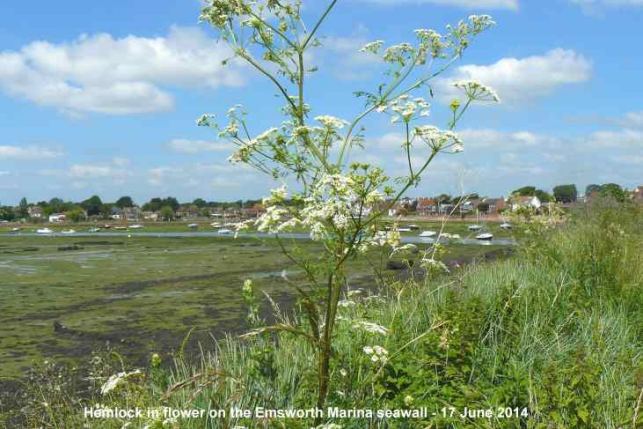
At the bottom of the
slope down to the main western track down Thorney
Island is a bush of Hop Trefoil with masses of
flower heads with 20-30 flowers in globular clusters.

Selfheal is also very
prominent in this area. I could only find three Bee
Orchids in flower, which is far less than I have
seen here in previous years.
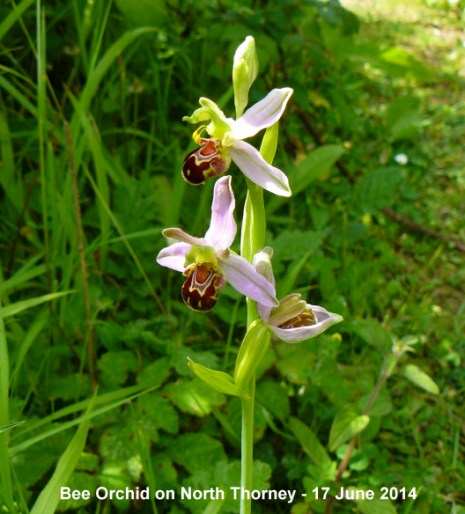
Water
Vole
At about
12:30, I stopped on the south bridge on Brook Meadow
on the way home to look for Water Voles and
dragonflies. I was watching a couple of very large
chunky hoverflies when Robin Pottinger came up to join
me. While we were chatting, a Water Vole popped out of
the vegetation on the east bank immediately below the
bridge where we were standing and proceeded to munch
away at the luxurious growth of Fool's Water-cress.
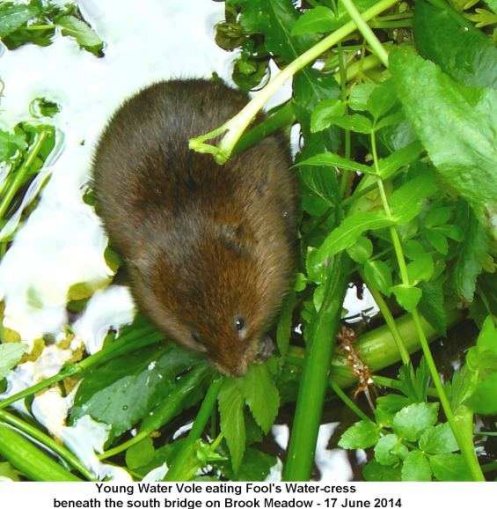
We were both sure this
was a youngster as it was distinctly smaller than the
normal adult and its fur was fresh and light brown,
unlike the often ruffled and scarred fur of adults. We
watched it for about 10 minutes as it fed, when it
scuttled northwards through the dense vegetation on
the river bank. We had several more sightings of the
vole in the greenery, when we confirmed our
impressions of a young Water Vole. A very nice
sighting, we both agreed!
Horntail
corrected
Ralph Hollins
corrected my identification of the black and yellow
fly that I photographed on the Emsworth wayside
yesterday. He said "a Horntail of either sex has the
back end of its body all yellow. As your specimen does
not have the long ovipositor it is not a female but I
think a male would still have the short backward
projection show in the 'side-on' view of the female. A
Horntail would have a noticeably bulkier body. My best
guess at your insect is the Ichneumon Fly
Amblyteles armatorius on page 231 of
Chinery and at http://lifeonanoxfordlawn.blogspot.co.uk/2010/09/ichneumon-wasp-amblyteles-armatorius.html
As always, Ralph is spot on. Many thanks.
Hedgehog
news
Graham Petrie
gives a link to a video on Facebook of a Hedgehog
argy-bargy around his feeding station in his Havant
garden. He thinks the aggressor may be Hogboy which
Graham has been caring for over the winter, but which
is now running freely.
https://www.facebook.com/photo.php?v=10204240230950258&l=683283567974427208
Fort
Purbrook
Jill Stanley
took a friend to Fort Purbrook yesterday to see the
orchids. They counted 13 Bee Orchids and 5 Knapweed
Broomrape although the latter were mostly over. They
also saw a lot of butterflies and here are two
excellent images Jill sent me of a Marbled White and a
Small Blue, both typical beautiful butterflies of
Portsdown Hill.
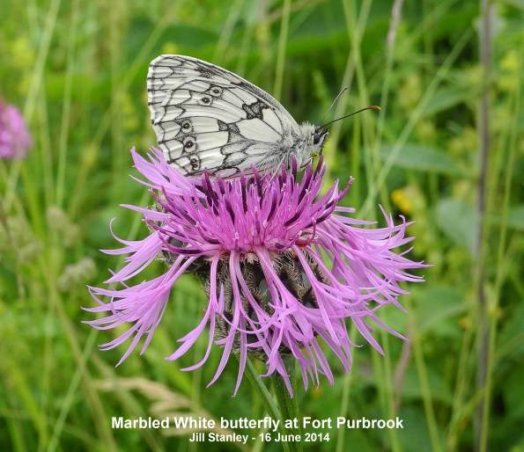

Hayling
Oysterbeds
Chris Cockburn
gives another up date of seabird news from the
oysterbeds - 16th June
Common Terns
"Firstly, the not-so-good news - the four most
recent high tides, peaking at c5m on 15 June at 01:35
have resulted in the numbers of 'apparently nesting'
Common Terns being reduced from 74 to 51; but, since
only eggs were lost, it is highly likely that the
'failed' pairs will find sufficient food for the
females to return egg-laying condition. Meanwhile, a
survey carried out by Wez Smith (the RSPB Site
Manager) on 15 June showed that there were 29
apparently nesting common terns (making the harbour
total 103 common tern nests this year). Wez also
reported that, so far (fingers crossed!!), little
terns were doing well on the harbour
islands.
Black-headed
Gulls
During the high tide period at the Oysterbeds today,
gull activity could only be described as a
noisy-mayhem! The tide height was worryingly high and
many of the black-headed gull families temporarily
lost their territories and moved elsewhere (not a good
idea for these fearfully territorial animals). Some
swam out the period,; but the gulls do not like to see
(other brood) chicks on the water (presumably,
swimming chicks might attract avian predators). So,
chicks afloat were being attacked by non-related gulls
while the shepherding parents rapidly launched into
noisy defensive attacks on the attackers, yes, mayhem!
The upshot was very noisy and often resulted in
(apparently) ferocious interactions (from even the
smallest of BH chicks!). The common terns were only
too happy to join in the frays - they are just as
"feisty" as the gulls.
Oystercatchers
Good news, two oystercatcher chicks have been
taken to the new shingle recharge by their parents -
the family might be from the lagoon islands but are
more likely to be from one of the northern bunds and
it will be a few months before true success can be
reported (almost uniquely amongst wader chicks,
oystercatcher chicks are "taught" for several months
by their parents on how to get food (most wader chicks
are able to feed themselves very quickly) - not
oysters, of course!!
Barrel
Jellyfish
And now for the different things, it's probably
not the most frequently sighted animal in the lagoon,
but a probable Barrel jellyfish - Rhizostoma octopus
(attached very poor photo) - maximum diameter of
c90cm.

They have generally
been described by the media in terms of "invasion of
enormous, giant jellyfish" For more reasoned
information see the following link . . .
http://www.marine-conservation.org.uk/ukjellyfish.html
Rhizostoma is described in this link as the 'basking
shark' of jellyfish, but despite its huge size, it
lives only on tiny plankton, and its sting is not
powerful enough to harm humans.
MONDAY
JUNE 16 - 2014
Emsworth
waysides news
Jane Brook and
I conducted our weekly survey of the Emsworth waysides
this morning. We covered three of the waysides in
North Emsworth, Southleigh Road (west), Barwell Grove
path and Greville Green (west).
Not officially a wayside, but on the verge by Cotton
Drive where I parked the car, the Rosy Garlic
is now seeding and looking just as attractive as when
I last saw it in flower on May 12th. Grid Ref: SU
74370735.
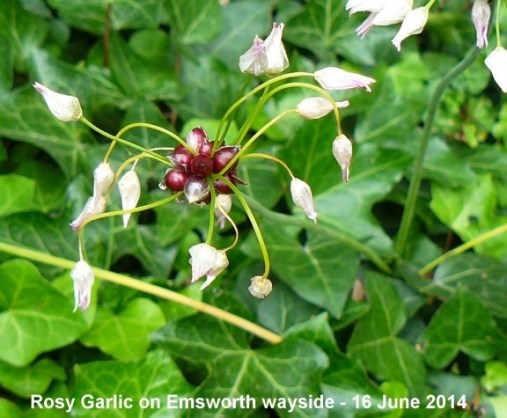
Smooth
Hawk's-beard was flowering well on the Horndean
Road traffic island at the eastern end of Southleigh
Road. We also saw plenty of it elsewhere on the
roadside verges, etc. Also on the traffic island, we
were very surprised to find a single plant of Sea
Beet. Less of a surprise was Lucerne. My first
Self-heal was in flower on the grass verge of
the Barwell Grove path.
While walking along
the Southleigh Road (west) wayside we watched a
distinctive black fly with yellow markings as it flew
from one plant to another hardly waiting a second
before taking off. I managed to get one shot in focus
which suggested a sawfly, possibly a Horntail?
Jane also spotted a pale green caterpillar of the
Orange Tip butterfly.
Horntail?

|
Orange
Tip caterpillar
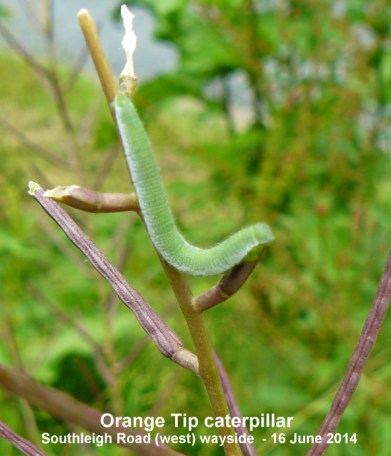
|
Hampshire
Farm
After
finishing the waysides survey I had a walk around the
new open space area of the Hampshire Farm development,
following Chris Oakley's visit yesterday. One cannot
but be impressed with the size and scale of the
project which includes many acres (how many?) of
freshly seeded grassland with tree plantations and
gravel paths and seats in various locations along with
a children's play area. The attenuation pond is
heavily fenced off. The site is clearly not officially
open yet, as there is still fencing around the area,
though there is a gap in the fence through which one
can easily gain access.

The grassland was
largely dominated by sown varieties of grass,
including masses of Crested Dog's-tail and Red
Fescue. Cultivated Oat with dead straight awns; Wild
Oat would have bent awns. Smooth Brome with drooping
panicles. Of the flowers Corn-cockle, Corn
Marigold and Common Poppy stood out as pretty sown
varieties. Tufts of Smooth Tare were
everywhere; presumably also sown.
Hairy Buttercups were widespread. I checked
their identification by digging one up and find a
root, but no bulb, ruling out Bulbous Buttercup. The
achenes also had a ring of warts inside a thick border
(Rose p.102).
I heard a Skylark singing from high in the sky,
which is good news as it means they will be nesting
there.
I saw just one butterfly, a Small
Tortoiseshell.
As I walked
northerwards towards Long Copse Lane the area got
distinctly rougher with less evidence of sown plants
and more truly 'wild' plants coming up, like Yorkshire
Fog, Common Couch and Creeping Thistle.
Italian
Ryegrass ?
In this area I
found several dense tufts of what could be Italian
Ryegrass, though I shall need to confirm this with
Martin Rand.

Martin Rand commented
"Yes, that certainly looks like either Lolium
multiflorum or its hybrid with Lolium perenne, L. x
boucheanum. But the awns are so well developed, I
think it will be the species. The young leaves will be
rolled, not folded, and the plant will be annual or
biennial (it comes up easily, though you may not want
to apply that test!)"
Generally, I did not
feel entirely comfortable in the sown grassland, like
I would in a proper meadow. The area had the feel of a
created landscape, which, of course, it was, so I
suppose I cannot complain about that. It was certainly
better than a boring old parkland with closely mown
grass, that is for sure! It will be interesting to see
how the site develops over the years and what type of
management will be undertaken; presumably an annual
hay cut will be carried out?
Harvest
Mouse
Malcolm Phillips went round Brook Meadow this
afternoon and got a good sighting of a small
mouse-like creature creeping around on a Butterbur
leaf at the north bank.
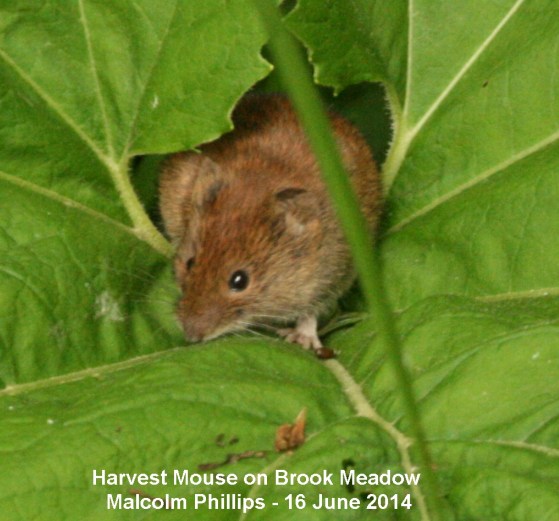
Malcolm's photos
clearly suggest a Harvest Mouse based on its small
size and russet brown fur and white underside. The
photos also show the animal to have a blunt nose,
small eyes and small hairy ears, all of which tally
with a Harvest Mouse. These were the first photos we
have had of a Harvest Mouse on Brook Meadow, though we
have found several likely nests.
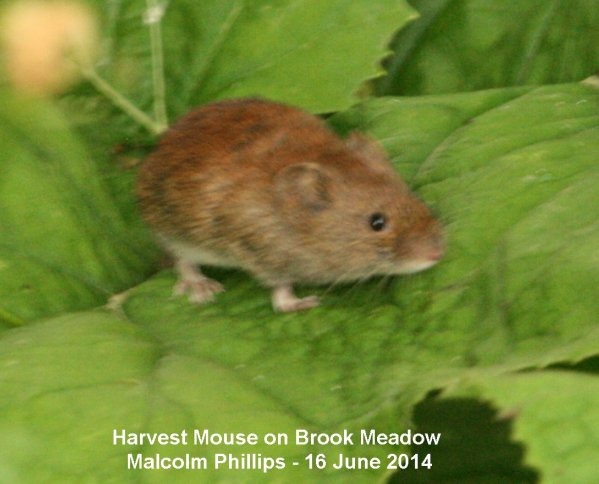
The Mammal Society
says Harvest mice are listed as a BAP (Biodiversity
Action Plan) Species because they are thought to have
become much scarcer in recent years and require
conservation plans to reverse the decline. Changes in
habitat management and agricultural methods are
thought to be the main cause for the loss of
populations from certain areas, although there have
been no reliable studies to quantify this
change.
Baffins
Pond
Eric Eddles
provides an update on the situation at Baffins Pond,
Portsmouth. "Since the demise of the dominant Cob we
now have six Mute Swans on the pond, but as yet no
cygnets. In recent weeks 80 plus Canada Geese come and
go and we have two pairs that have successfully bred
eight in total goslings. The Barnacle Geese still have
two remaining of the original five goslings. Coots and
Moorhens have had a good year with quite a few
youngsters growing fast and a small number of Mallard
ducklings also."
SUNDAY
JUNE 15 - 2014
Millpond
News
The pen
Mute Swan was sitting high on her tower nest on
the town millpond near the bridge when I passed by
this morning, no doubt brooding 6 eggs which I reckon
are still some way off hatching (a week or even
two?).
The Mute Swan family with its two remaining
cygnets was on Peter Pond along with a motley
collection of gulls, ducks and Coot.
Over on Slipper Millpond both Great Black-backed
Gulls were present, with one on the water and the
other on the centre raft with one rapidly developing
chick. I watched the adult feeding the chick and am
now certain there is only one chick this year.

I was rather surprised
to find one of the Coot families with four
growing chicks still intact on the east side of the
pond, having avoided the predatory instincts of the
gulls. Maybe, they are not so aggressive this year,
having only one chick to feed?
A Reed Warbler was singing from the reedbeds on
the north west side of the pond.
Other
news
Walking along
the path on the west side of Peter Pond towards
Gooseberry Cottage I found a very good crop of
Hairy Tare. Hairy Tare is a bushy, scrambling,
pea-type plant with spikes of tiny pale lilac flowers
at the top of long stalks. It does not grow on Brook
Meadow, but can always be found along the edges of
this path, but never in my memory in quite the
abundance it was today.
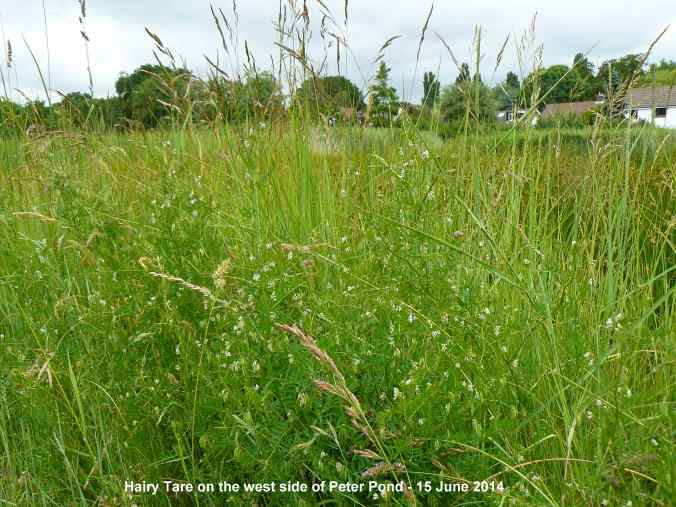
Another plant which
does not grow on Brook Meadow, but which can be seen
along this path is Rough Chervil, characterised by its
rough purple-marked stems. Perforate St John's-wort
was in flower on the south bank of Peter Pond.
Burnet
Moths
Both 5-spot
and 6-spot Burnet Moths are seen on Brook Meadow; they
are attractive bright red moths with 5 or 6 spots on
their wings, respectively. But if you want to see
5-spots then have a look at the patch of ground to the
west of Peter Pond, owned by Lillywhite's Garage -
called the Lillywhite's patch. Today, I found about 20
adult 5-spot Burnet Moths, either resting on
vegetation or feeding on the flower heads of Hemlock
Water-dropwort on this path. They look rather like big
red Bumblebees in flight. Here is one feasting on
Hemlock Water-dropwort.
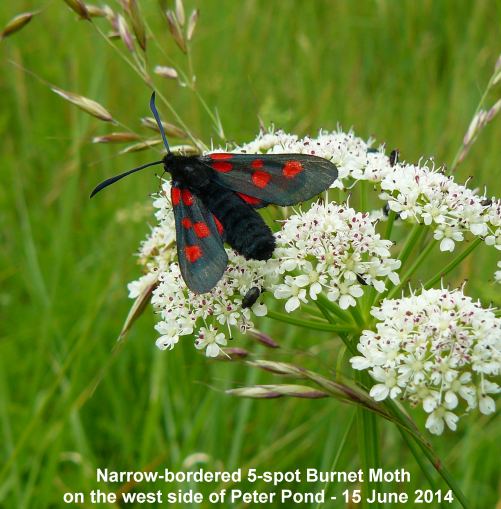
There were also the
silken cocoons attached to stems of grasses from which
fresh adults can be seen emerging which Malcolm
Phillips has recently captured on camera.
Brook
Meadow
A Moorhen
with two small chicks wason the river north of the
north bridge. Here is a beautiful male Azure
Damselfly which perched briefly for a photo on the
Bramble path.
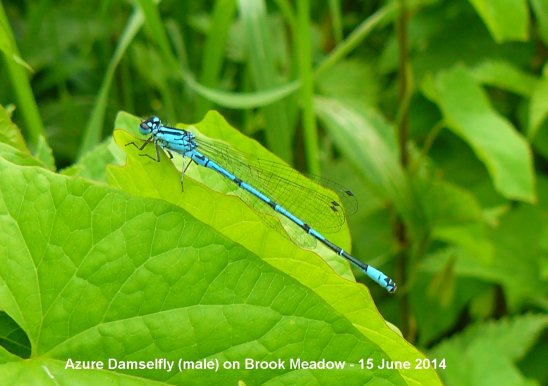
Large Bindweed
is in flower for the first time this year as is
Meadowsweet.

Judging from the
masses of flowers on the Brambles in the north
west corner of the meadow, there will be a bumper crop
of Blackberries this year.
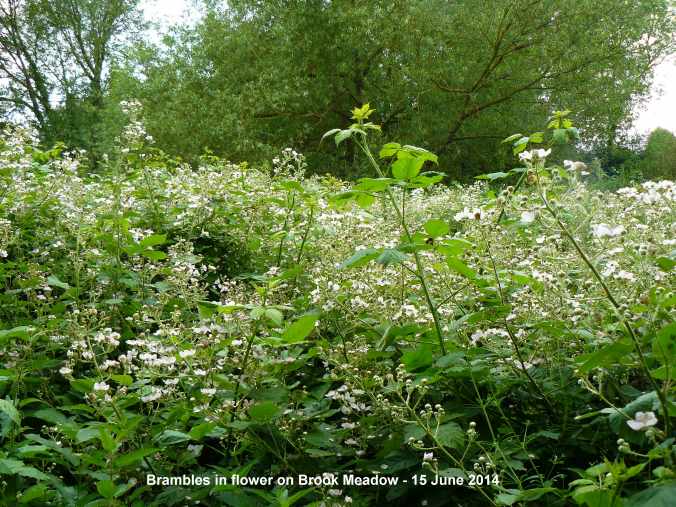
Grasses are the main
feature on Brook Meadow, with Tall Fescue
particularly dominant with its characteristic habit of
bending over to one side. But Reed Canary-grass
towers over all the others, prominent just north of
the causeway from the Lumley gate. The Festulolium
Hybrid can be easily recognised on the east side
of the north meadow south of Beryl's seat.
I was very pleased to
find some Toad Rush on the cross path from the
Lumley gate, which had been avoiding me so far this
year. Grid Ref: SU 75139 06017. Sharp-flowered Rush is
also just starting to flower.
Waysides
News
Newly
flowering on the Emsworth Railway Wayside were
Great Willowherb, Creeping Thistle and Spear
Thistle.
Hampshire
Farm
Chris Oakley
had a walk around the Hampshire Farm site today. He
says, although there is still no sign as to when it
will be officially opened, people are walking there
quite freely. He walked up to the top end bordering
Long Copse Lane where the grass was very thick and
tall. He was delighted to see a pair of Roe deer again
after a long break. He also spotted three Skylarks,
which he has not seen there for more than two years.
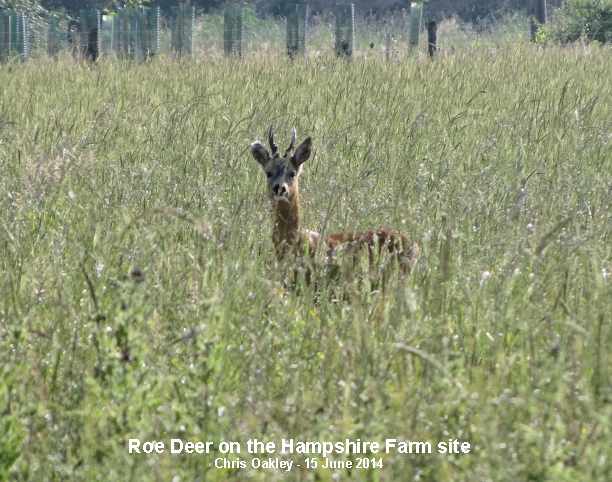
SATURDAY
JUNE 14 - 2014
Millpond
News
I happened to
catch sight of the Mute Swan rising briefly from her
'litter nest' on the town millpond near the bridge to
reveal no less then 6 eggs. This is two more than the
four I saw on June 11th which suggests she is still
laying! I had predicted June 22nd for hatching, but
that could well be much longer.
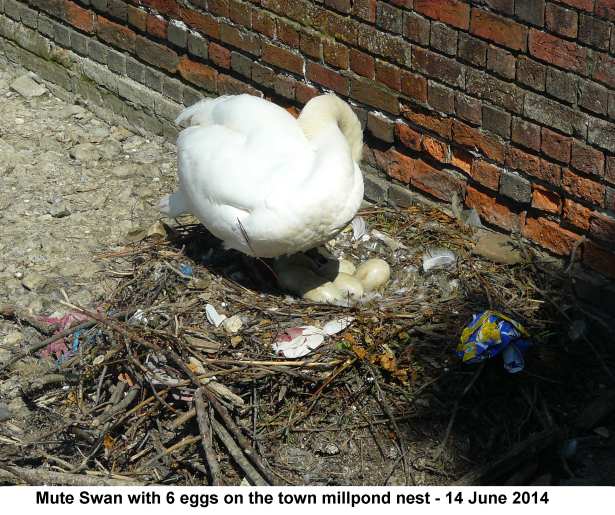
5-spot
Burnet Moth
Regarding the
5-spot Burnet Moth that Malcolm Phillips had on Brook
Meadow yesterday, thanks to Ralph Hollins for pointing
out that the standard Five Spot Burnet is nowadays
almost extinct in Hampshire and what we see is the
Narrow-bordered Five Spot. For comments on the Narrow
Bordered species see http://www.hantsmoths.org.uk/species/0171.php
Recent
butterfly sightings
Ralph Hollins
informed me that Barry Collins has already seen Silver
Washed Fritillaries in Havant Thicket (on June 13) and
it appears that one of this years 'English'
Swallowtails has been seen in East Hampshire at Four
Marks on June 12 - both species might appear locally.
Ralph summarises recent butterfly 'firsts in Hants and
Sussex ' ...
June 8 Silver-Studded Blue
June 10 White-Letter Hairstreak at IBM Cosham
June 11 Dark Green Fritillary
June 12 Silver Washed Fritillary and Small Skipper
June 13 Ringlet
Fort
Purbrook
Ros Norton
reported on this morning's walk by the Havant Wildlife
Group:
For full report see . . . http://familyfellows.com/hwg-walk-reports-2014.htm
Brook
Meadow honour
Just a quick
note to say how deeply honoured I am to have been
awarded a British Empire Medal (BEM) on the Queen's
Birthday Honours List for my conservation work -
mainly on Brook Meadow. I am immensely proud of what
has been achieved on the site by all the volunteers
and advisors and would like to thank all of them for
their help and sterling efforts over the years. The
medal is really as much theirs as mine. I am deeply
grateful for all the work they have done (and continue
to do) to create such an attractive site, crammed with
wildlife and so well loved by the local community.
It's a great testamount to them all. Thanks!
PS The Portsmouth News got it wrong in today's issue
of the paper - the award is a BEM and not a MBE. See .
. . http://www.portsmouth.co.uk/news/local/queen-s-birthday-honours-emsworth-conservationist-wins-mbe-1-6119427
FRIDAY
JUNE 13 - 2014
Brook
Meadow
Malcolm
Phillips had an interesting time on the meadow today.
He saw a Water Vole about 30ft up river from the south
bridge then to his surprise a small Water Vole
climbed up a branch and sat about 1ft above the
water eating the leaves. Unfortunately, Malcolm could
not get a reasonable photo of this vole.
Another interesting sighting was of a couple of
5-spot Burnet Moths feeding on a Red
Clover
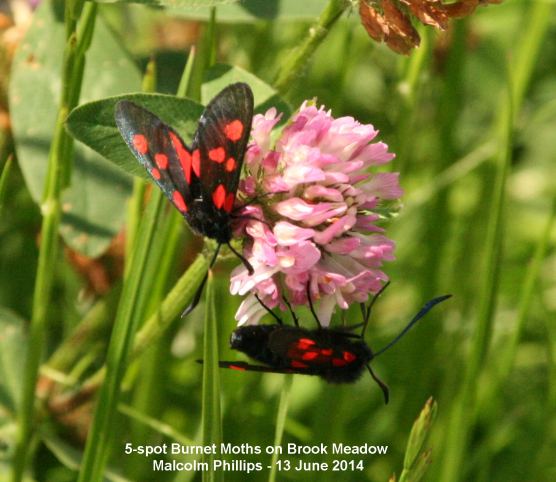
and another one just
emerging from its cocoon
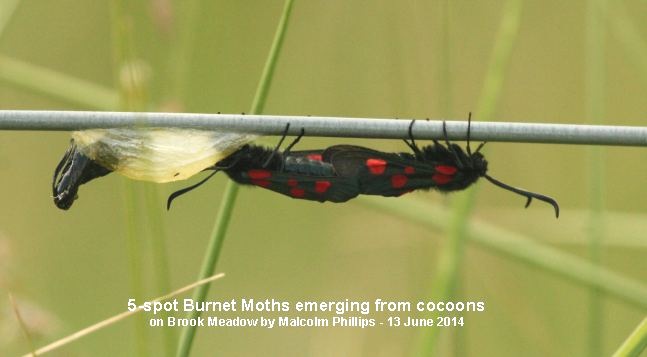
THURSDAY
JUNE 12 - 2014
Mullein
moth
My wife was
working in the garden this afternoon when she came
across two of these highly colourful caterpillars
feeding a Verbascum plant.

They are the larvae of
the Mullein Moth and are fairly common in gardens; we
have certainly seen them before. The adult moths are
very dull in comparison with the caterpillars, a pale
straw colour and remarkably twig-like, and hence are
very rarely seen.
Brook
Meadow
Malcolm
Phillips spent some time round the meadow today and
saw a good selection of butterflies, including Orange
Tip (getting towards the end), Red Admiral, Large
Skipper, Speckled Wood and Comma (first of the summer
brood?).
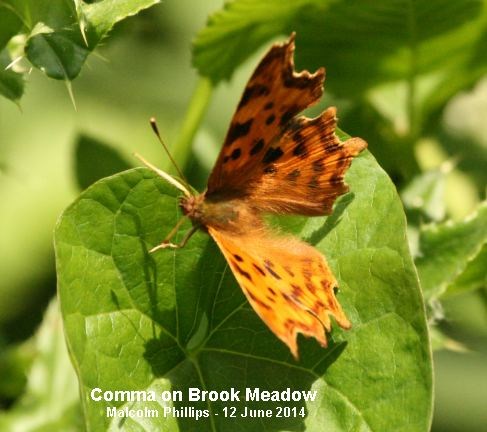
Bee
Orchids galore
I had a
message from Peter Gray to say there are/were over 100
Bee Orchids opposite flat 245 Eastern Road, Portsmouth
which have been marked by the council with
white-topped posts. It must be a good year for them?
For
earlier observations go to . . June
1-15